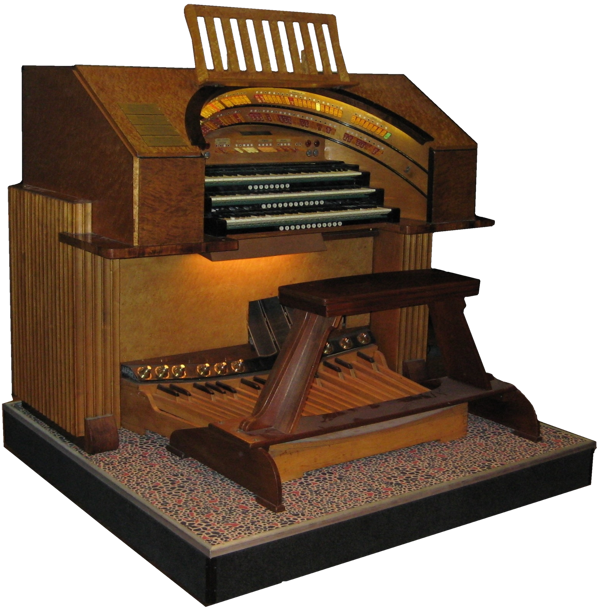continuation of part 1
Flue Clarinet
In addition to the piano consoles, Standaart also developed theatre organs with other types of console. Small, compact organs with two manuals and three to seven ranks, with a ‘straight’ console were made, but also consoles in the ‘horseshoe’ form, without a built-in piano. An advertisement from 1928 speaks of “Wonder organs for small theatres” from fl.6800,- (Dutch guilders). In a church in Veenhuizen there is a small Standaart organ, probably the oldest Standaart organ still in existence. Unfortunately it is not in very good shape and the Vox Humana and percussions have been missing since the organ was moved to the church in 1960. It probably came from a theatre in Tilburg.
The Schiedam Tivoli (later owned by dhr. Paap and now by the NOF) is probably from the same time period.
This organ has four ranks: a (Rohr) Flute; a Violine; a Vox Humana and a Clarinet. This last stop is remarkable as it is a flue stop, named ‘Clarinette’. Normally a Clarinet in an organ is a reed stop. The flue version was much cheaper to produce, although it does not have the fuller tone of a true reed stop.
Quite a few of these smaller instruments were produced but the majority have disappeared. Thankfully the organ from the Colosseum (now in the Larenkamp, Rotterdam) has been preserved. This also has a flue clarinet from the same period. Thanks to dhr. Slingerland, this organ is still playing.
In 1926 Standaart also had an organ with a so-called ‘roll’ mechanism from a German manufacturer. This was situated in Asta-Amsterdam. Not much is known about this instrument and no other examples of this type have been discovered. It is likely that this combination was not a success for some reason.
Luxor – Rotterdam
In 1928 Standaart installed an organ in the Luxor theatre in Rotterdam. This organ was noteworthy, as it was much larger than any organ built before. The organ had three chambers (one on each side of the stage and an echo chamber up in the roof); 1500 pipes and three manuals. The exact number of ranks is difficult to discern from the specification because the organ was partially unified and partially ‘straight’, with separate stops on each manual. There could well have been 15 or so ranks, certainly considering the number of pipes mentioned. In the chambers on the left and right only the Flute and the Tibia were unified, and in the echo chamber, a second Tibia and a Trumpet.
‘Unified’ in this case simply means available at various pitches but not available on other manuals, as Wurlitzer, Compton and most other theatre organ makers had been doing for a long time. Standaart thus kept to a conservative ‘church organ’ course with a single row of pipes for each stop tab. In light of this, it is perhaps understandable that Theo Strunk adopted the same approach with the Asta organ in The Hague and later with the City organ in Amsterdam. He was employed by Standaart for some years before striking out on his own in 1928 and in doing so becoming a direct competitor of Standaart’s. From that moment on the two men couldn’t stand one another. Strunk undoubtedly took his experience of specification design with him from Standaart.
Strunk also had another conviction: he was bent on constructing organs that had a dual character — both theatre and church organ, even to the extent of including mixtures. Two organs in one is usually a concept doomed to failure, as Reginald Foort is reported to have said of the City organ: “this organ is not good, and it is not bad!” The use of echo chambers in the organs of the Asta (The Hague) and City (Amsterdam) theatres was also conspicuous.
Back to Standaart
The Luxor organ must have been a prestigious project for Standaart. “A threefold orchestral organ, the largest yet built in Europe. What this firm from Schiedam has produced is among the finest to be found in any theatre in the world”, according to one newspaper.
It cost fl.60.000,-. Here for the first time we find Tibias — in the earlier instruments by Standaart this stop was not included.
Unfortunately things did not go well for this instrument, which was badly damaged during the war. From Cor Standaart’s personal archive we learn that the organ, which had been neglected and had fallen into some disrepair, was restored in 1952. ‘Concert microphones’ were also installed for better sound in the hall but a few years after that the organ was removed and passed into private ownership.
Source: NOFiteiten 2006 nr. 1
>> To part 3



